
Most of us don't think about cleaning the dishwasher very often (Im guilty). After all, if the dishes are getting cleaner, shouldn't the dishwasher get cleaner, too? Unfortunately, debris and deposits do build up over time, and some of them reduce the performance of the dishwasher.
With this in mind, I surfed the Net to find out more. WikiHow is the source of information here, and heres what I found out. First off, the good news is dishwashers don't need cleaning very often and it's not hard to clean them. Here's what we should do:
Use your dishwasher regularly. It will help to prevent food and other debris from building up in there, reducing the need to clean it.
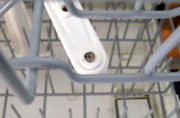 Run the dishwasher or wait until just after you've run it, then empty the dishwasher completely.
Run the dishwasher or wait until just after you've run it, then empty the dishwasher completely. Do the other steps with the dishwasher empty.
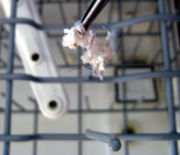
For a clogged hole,
check all the spinning arms. Look to make sure all the holes are open so that water can run through them freely. The hole in this photo has accumulated some debris.
Clear any debris out of the holes in spinning arms. Use fine pointed or needle-nose pliers if you have some. Otherwise, try a toothpick or something similar. Take care not to scratch anything if you're using a tool with a metal point. If these holes are very small, bend a fine wire with a tiny hook on one end.
Thread the wire through the opening most distal from the center of the arm. Each time you do this a small amount of debris will come out. This is time consuming. Another option is to drill a much larger hole at the end of the arm. Run the washer to eject the matter, then plug the bigger hole with a stainless steel screw.
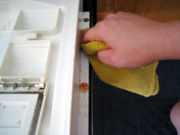 For spills and splatters, wipe around the edges of the door and around the gasket.
For spills and splatters, wipe around the edges of the door and around the gasket. This space doesn't get washed during the dishwasher cycle. Use a damp cloth and, if you like, a bit of mild spray cleaner. An old toothbrush or other soft, household brush can help get into corners and up under the gasket.
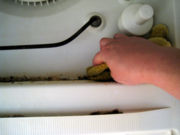 Be sure to clean under the bottom of the door.
Be sure to clean under the bottom of the door. In some dishwashers, this is a dead spot where water doesn't go, so it can accumulate debris. Wipe this off.
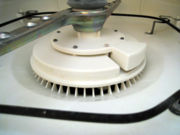 Inspect the bottom of your dishwasher around the drain for debris.
Inspect the bottom of your dishwasher around the drain for debris. There will be a grate or grill around it, under the arm. This is where wastewater goes. Look for debris clogging up this area. You shouldn't have to clean this often if you're careful about what you put in your dishwasher, but you should remove any solid matter that builds up, especially bits of paper, shards of broken dishes, gravel, etc. You may be able to pick up solid objects accumulated on the outside by hand. If you think stuff has gotten down inside, you'll have to do some simple disassembly to get at it.
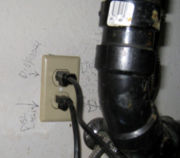
Start by unplugging. These outlets have been labeled to reduce confusion. Look for a plug under your sink. Make sure to unplug the dishwasher and not the garbage disposal.
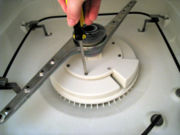
Carefully remove the screws, taking care not to drop them. The cover will lift off, leaving the area exposed. As you disassemble this section, take care to notice what you take off and where. Take photos along the way and set the pieces someplace safe, in the order they came off. Place a piece of tape on the opening to prevent debris from getting in it as you clean it. Use a cloth or your fingers to remove solid debris. Be careful of handling broken glass if that is part of what you find here.
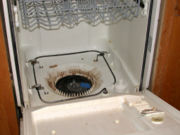
The blue tape covers an opening temporarily so this stuff doesn't get inside. Use a brush or a cloth to loosen and remove deposits. Screw everything back together, doing the reverse of what you did to get it apart. Don't over-tighten the screws, especially if they are going into soft plastic. Plug the dishwasher back in.
Remove hard water deposits or scale, if needed. Run one cycle of your dishwasher empty, with a mild, food acid of your choice. Do this after you've done the other cleaning steps here, so that it will also take care of anything your cleaning missed or knocked loose. A "light" or short cycle is usually sufficient. Place powders into the detergent cup. Place liquids in a right-side-up cup or bowl in the top rack. Use whichever of the following is on hand or inexpensive:
Lemonade drink mix or lemon-flavored Kool-Aid mix. Don't use strong colors that might stain. There is no need to add the sugar.
Tang (powdered)
Lemon juice
Distilled white vinegar
A dishwasher cleaning product
 Remove mildew or mold with bleach. Run a separate cycle from any acid cleaners you have used and never mix bleach with other cleaners or with dishwasher detergent. If mold and mildew is a problem, leave the dishwasher loosely open for a while after each cycle to allow it to dry out. Avoid using bleach and detergents containing bleach if your dishwasher has a stainless steel interior or door. Bleach is a very strong chemical, both on you and on your dishwasher, so use it sparingly and only when necessary.
Remove mildew or mold with bleach. Run a separate cycle from any acid cleaners you have used and never mix bleach with other cleaners or with dishwasher detergent. If mold and mildew is a problem, leave the dishwasher loosely open for a while after each cycle to allow it to dry out. Avoid using bleach and detergents containing bleach if your dishwasher has a stainless steel interior or door. Bleach is a very strong chemical, both on you and on your dishwasher, so use it sparingly and only when necessary.
Tackle rust stains. Use a dishwasher-safe rust remover for the stains themselves, but ask how they got there in the first place. If the finish is chipping or flaking off the wire baskets in your dishwasher, try a paint-on sealant made just for dishwasher racks. Pull out the racks and check the bottoms, too. If the damage is severe or widespread (not just a few tines but all of them), see if you can replace the entire rack. Online stores sell a wide variety of appliance parts, so your replacement part may be very easy to find.
If your water has a lot of iron or rust in it, rust may be beyond your control. If possible, address the problem at its source. If the problem isn't rusty pipes, water softeners can remove a limited amount of iron from water but they mostly work by exchanging minerals that are hard to clean off surfaces for salts that are relatively easy to clean. Filters do exist to remove iron from water and might be worth looking into if your water is extremely high in iron.
 Spray the front of your dishwasher with a mild spray cleaner of your choice and wipe it with a sponge or soft cloth. Pay particular attention to the controls and the handle. Also, don't miss the little ledge between panels. It tends to collect dirt.
Spray the front of your dishwasher with a mild spray cleaner of your choice and wipe it with a sponge or soft cloth. Pay particular attention to the controls and the handle. Also, don't miss the little ledge between panels. It tends to collect dirt.
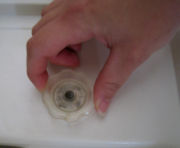 Refill your dishwasher's rinse aid dispenser about once per month. Rinse aid helps to prevent spots on your dishes. Unscrew the round knob in the dishwasher door and pour in rinse aid according to package directions or your dishwasher's manual. Depending upon your specific water chemistry, you may be able to substitute white vinegar for a "rinse aid." Experiment and see if this is right for your dishwasher.
Refill your dishwasher's rinse aid dispenser about once per month. Rinse aid helps to prevent spots on your dishes. Unscrew the round knob in the dishwasher door and pour in rinse aid according to package directions or your dishwasher's manual. Depending upon your specific water chemistry, you may be able to substitute white vinegar for a "rinse aid." Experiment and see if this is right for your dishwasher.
Don't use rinse aid if you have a water softener. Solid rinse aids are available. If you forget to refill liquid rinse aid, the solid ones are more visible, so they may help you remember. If you prefer, some dishwasher detergents now have built-in rinse aid.
 Clean the flatware basket with a brush if there is any accumulated debris. Liquid dish soap will help.
Clean the flatware basket with a brush if there is any accumulated debris. Liquid dish soap will help.
Now here are some all-around dishwasher maintenance tips:
Promptly pick up any objects that fall to the bottom of the dishwasher.
Run the garbage disposal before starting the dishwasher. The dishwasher drains into the same pipe as your sink, so that drain must be clear.
Run a bit of hot water in your sink before running the dishwasher. You will get cleaner dishes if the water starts hot. You can collect the water you run and use it for watering plants or other purposes. Run the water until what comes out of the tap feels hot.
Make sure your water starts hot enough. Set the thermostat on your water heater to 120 F. Water that is cooler than this won't do a good job cleaning. Water that is hotter could scald.
Load your dishwasher properly, stacking items facing downward and inwards. Check that all the arms can spin freely before running the dishwasher.
Run full loads to conserve water and energy, but don't pack dishes too tightly. Dishwashers wash dishes by spraying water over them, so the water needs to be able to get to the dishes to clean them.
Don't wash containers with labels that could come loose. Scrape heavy debris and large particles off dishes before placing them in the dishwasher.
Don't pre-rinse too much. Dishwashers and detergents have both improved. If you haven't tried putting dishes in dirty lately, try it again. You may be pleasantly surprised.
Not all dishwasher detergents work the same. The next time you buy a new container of detergent, try a different brand and see if you get better results. Look for ratings and reviews, too. At the very least, favor powders and tablets over gels and liquids, and keep them dry and free of excess moisture prior to use.
Wash small items in the basket with your forks and knives so they don't slip through the racks and end up in the bottom. Some dishwashers even have enclosed baskets just for small items.
For dried-on gunk, get the area wet or spray the cleaner, then let it sit and dissolve for a few minutes before wiping. You'll save yourself a lot of scraping and scrubbing.
Wear gloves if you prefer not to touch the cleaner or the debris.
Finally, three warnings:
NEVER mix household cleaners, especially bleach, with other cleaners or chemicals.
If you're not comfortable doing some simple disassembly and reassembly, don't unscrew the stuff in the bottom of the dishwasher. It doesn't need frequent cleaning.
Use only detergents designed for use in dishwashers, not the liquid dish soap (washing up liquid) that you use to wash dishes by hand. The dishwasher is designed to contain water spraying from certain directions, not a thick layer of suds. You'll only make a mess.
Contribute to the Cook'n Club!
DVO would love to publish your article, prose, photography and art as well as your cooking, kitchen and nutrition tips, tricks and secrets. Visit the Newsletter Submission / Win Win for All section in our Forum for more information and details.



